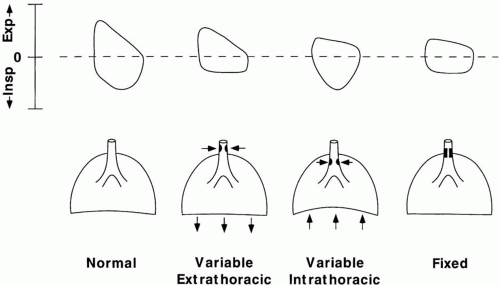Ventilatory failure is managed by defining its cause, by correcting reversible problems, and by providing mechanical support when required. If the cause of ventilatory failure is not obvious, bedside measurements intended to determine the mechanisms at work are especially important. Ventilatory workload is reflected in the [V with dot above]
E and machine pressures needed to deliver the tidal volume (see
Chapter 5). Important factors contributing to the minute ventilation requirement include levels of alertness, agitation, pain or discomfort, body size and temperature, pathologic metabolic stress (sepsis, trauma, burns, etc.), ventilatory dead space fraction, nutritional status, and the work of breathing. The difficulty of chest inflation per liter of ventilation is best gauged by the peak dynamic and static (plateau) inflation pressures as well as by the estimated values for resistance, compliance, and auto-PEEP. Neuromuscular function is evaluated by observing the ventilatory pattern, the tidal volume and breathing frequency, and the actions of the respiratory muscles. At the bedside, the appropriateness of ventilatory drive is often best assessed by examining the pH and PaCO
2 in relation to breathing effort. (For example, if PaCO
2 is high and pH is low, drive may be deficient, muscular reserve may be inadequate, or both; evidence of patient agitation, dyspnea, or distress argues for primacy of the latter.) Integrative indices of demand and capacity, such as the rapid shallow breathing index or the tidal mouth occlusion pressure (
P0.1), which is just now coming into clinical use as a quantitative drive index, may be helpful when assessing the continuing need for machine support (see
Chapter 10).
Correcting Reversible Factors
The quest to determine the cause for ventilatory failure should be guided by a systematic evaluation of ventilatory drive, [V with dot above]
E, the work of breathing, and neuromuscular performance. In passive ventilated patients, resistance and compliance can be measured during constant flow ventilation (see
Chapter 5). Therapy to reverse ventilatory failure should be guided by knowledge of the underlying defect and its severity (
Table 25-2). Impedance can be improved by relieving airway obstruction (bronchodilation, secretion clearance, placement of a larger endotracheal tube, etc.), by increasing parenchymal compliance (reduction of atelectasis, edema, and inflammation), and by improving chest wall distensibility (drainage of air or fluid from the pleural space, relief of abdominal distention, muscle relaxation, or analgesia). A common problem overlooked in ventilated patients is a closed circuit suction catheter inadvertently left in an advanced position beyond the wye piece. This partial occlusion dramatically narrows the effective caliber of the endotracheal tube and is easily remedied by withdrawing the catheter to its usual position.
Serum chemistries and medication list must be carefully reviewed for potential suppressants of mental status or muscular strength. Neuromuscular efficiency should be optimized by ensuring alertness, maintaining the patient in an appropriate position (usually as upright as possible), relieving pain, and addressing electrolyte disturbances, nutritional deficiencies, and endocrine disorders.
Elevations of ammonia, an endogenous suppressor of consciousness and drive to breathe, should be addressed by reducing correctable sources of its generation—upper GI bleeding, depakote, etc.—by encouraging its gut elimination (lactulose), or by enhancing the metabolism of ammonia to glutamine and hippurate, by using ornithine or benzoate, respectively. Although Addison disease is rare, adrenal insufficiency (absolute or, more commonly,
relative) is surprisingly common among critically ill and chronically debilitated patients who undergo major physiologic stress. Measures that improve cardiac output or arterial oxygenation also will improve neuromuscular performance. Treatable neuromuscular disorders (e.g., myasthenia, polymyositis, Parkinson disease) should not be overlooked. Some problems of decreased ventilatory drive are self-limited (e.g., sedative or opiate excess); others improve with nutritional repletion, electrolyte adjustment (metabolic alkalosis), hormone replacement (e.g., hypothyroidism), or recovery of mental status. Very few respond to nonspecific ventilatory stimulants such as progesterone. (Obesity hypoventilation syndrome may be one exception—see following discussion.) Unfortunately, many such problems are refractory to drug manipulation and must be treated by optimizing ventilatory mechanics with the goal of reducing the work of breathing sufficiently to restore compensation.




 , Mg2+, K+
, Mg2+, K+





